SLOS896B December 2014 – January 2017 OPA2314-Q1 , OPA314-Q1 , OPA4314-Q1
PRODUCTION DATA.
- 1 Features
- 2 Applications
- 3 Description
- 4 Revision History
- 5 Pin Configuration and Functions
- 6 Specifications
- 7 Detailed Description
- 8 Application and Implementation
- 9 Power Supply Recommendations
- 10Layout
- 11Device and Documentation Support
- 12Mechanical, Packaging, and Orderable Information
Package Options
Mechanical Data (Package|Pins)
- DBV|5
Thermal pad, mechanical data (Package|Pins)
Orderable Information
6 Specifications
6.1 Absolute Maximum Ratings
over operating free-air temperature range (unless otherwise noted) (1)| MIN | MAX | UNIT | ||
|---|---|---|---|---|
| Supply voltage | 7 | V | ||
| Voltage(2) | Signal input terminals | (V–) – 0.5 | (V+) + 0.5 | V |
| Current(2) | Signal input terminals | ±10 | mA | |
| Output short-circuit(3) | Continuous | mA | ||
| Operating temperature, TA | –40 | 150 | °C | |
| Junction temperature, TJ | 150 | °C | ||
| Storage temperature, Tstg | –65 | 150 | °C | |
(1) Stresses beyond those listed under Absolute Maximum Ratings may cause permanent damage to the device. These are stress ratings only, which do not imply functional operation of the device at these or any other conditions beyond those indicated under Recommended Operating Conditions. Exposure to absolute-maximum-rated conditions for extended periods may affect device reliability.
(2) Input terminals are diode-clamped to the power-supply rails. Input signals that can swing more than 0.5 V beyond the supply rails must be current limited to 10 mA or less.
(3) Short-circuit to ground, one amplifier per package.
6.2 ESD Ratings
| VALUE | UNIT | ||||
|---|---|---|---|---|---|
| V(ESD) | Electrostatic discharge | Human body model (HBM), per AEC Q100-002(1) | ±2000 | V | |
| Charged device model (CDM), per AEC Q100-011 | ±1000 | ||||
(1) AEC Q100-002 indicates HBM stressing is done in accordance with the ANSI/ESDA/JEDEC JS-001 specification.
6.3 Recommended Operating Conditions
over operating free-air temperature range (unless otherwise noted)| MIN | NOM | MAX | UNIT | ||
|---|---|---|---|---|---|
| VS | Supply voltage | 1.8 (±0.9) | 5.5 (±2.75) | V | |
| TA | Ambient operating temperature | –40 | 125 | °C | |
6.4 Thermal Information: OPA314-Q1
| THERMAL METRIC(1) | OPA314-Q1 | UNIT | |
|---|---|---|---|
| DBV (SOT-23) | |||
| 5 PINS | |||
| RθJA | Junction-to-ambient thermal resistance(2) | 221.7 | °C/W |
| RθJC(top) | Junction-to-case(top) thermal resistance(3) | 144.7 | °C/W |
| RθJB | Junction-to-board thermal resistance(4) | 49.7 | °C/W |
| ψJT | Junction-to-top characterization parameter(5) | 26.1 | °C/W |
| ψJB | Junction-to-board characterization parameter(6) | 49 | °C/W |
| RθJC(bot) | Junction-to-case(bottom) thermal resistance(7) | N/A | °C/W |
(1) For more information about traditional and new thermal metrics, see the Semiconductor and IC Package Thermal Metrics application report.
(2) The junction-to-ambient thermal resistance under natural convection is obtained in a simulation on a JEDEC-standard, high-K board, as specified in JESD51-7, in an environment described in JESD51-2a.
(3) The junction-to-case (top) thermal resistance is obtained by simulating a cold plate test on the package top. No specific JEDEC-standard test exists, but a close description can be found in the ANSI SEMI standard G30-88.
(4) The junction-to-board thermal resistance is obtained by simulating in an environment with a ring cold plate fixture to control the PCB temperature, as described in JESD51-8.
(5) The junction-to-top characterization parameter, ψJT, estimates the junction temperature of a device in a real system and is extracted from the simulation data for obtaining RθJA, using a procedure described in JESD51-2a (sections 6 and 7).
(6) The junction-to-board characterization parameter, ψJB, estimates the junction temperature of a device in a real system and is extracted from the simulation data for obtaining RθJA, using a procedure described in JESD51-2a (sections 6 and 7).
(7) The junction-to-case (bottom) thermal resistance is obtained by simulating a cold plate test on the exposed (power) pad. No specific JEDEC standard test exists, but a close description can be found in the ANSI SEMI standard G30-88.
6.5 Thermal Information: OPA2314-Q1
| THERMAL METRIC(1) | OPA2314-Q1 | UNIT | |
|---|---|---|---|
| DGK (VSSOP) | |||
| 8 PINS | |||
| RθJA | Junction-to-ambient thermal resistance(2) | 138.4 | °C/W |
| RθJC(top) | Junction-to-case(top) thermal resistance(3) | 89.5 | °C/W |
| RθJB | Junction-to-board thermal resistance(4) | 78.6 | °C/W |
| ψJT | Junction-to-top characterization parameter(5) | 29.9 | °C/W |
| ψJB | Junction-to-board characterization parameter(6) | 78.1 | °C/W |
| RθJC(bot) | Junction-to-case(bottom) thermal resistance(7) | N/A | °C/W |
(1) For more information about traditional and new thermal metrics, see the Semiconductor and IC Package Thermal Metrics application report.
(2) The junction-to-ambient thermal resistance under natural convection is obtained in a simulation on a JEDEC-standard, high-K board, as specified in JESD51-7, in an environment described in JESD51-2a.
(3) The junction-to-case (top) thermal resistance is obtained by simulating a cold plate test on the package top. No specific JEDEC-standard test exists, but a close description can be found in the ANSI SEMI standard G30-88.
(4) The junction-to-board thermal resistance is obtained by simulating in an environment with a ring cold plate fixture to control the PCB temperature, as described in JESD51-8.
(5) The junction-to-top characterization parameter, ψJT, estimates the junction temperature of a device in a real system and is extracted from the simulation data for obtaining RθJA, using a procedure described in JESD51-2a (sections 6 and 7).
(6) The junction-to-board characterization parameter, ψJB, estimates the junction temperature of a device in a real system and is extracted from the simulation data for obtaining RθJA, using a procedure described in JESD51-2a (sections 6 and 7).
(7) The junction-to-case (bottom) thermal resistance is obtained by simulating a cold plate test on the exposed (power) pad. No specific JEDEC standard test exists, but a close description can be found in the ANSI SEMI standard G30-88.
6.6 Thermal Information: OPA4314-Q1
| THERMAL METRIC(1) | OPA4314-Q1 | UNIT | |
|---|---|---|---|
| PW (TSSOP) | |||
| 14 PINS | |||
| RθJA | Junction-to-ambient thermal resistance(2) | 121 | °C/W |
| RθJC(top) | Junction-to-case(top) thermal resistance(3) | 49.4 | °C/W |
| RθJB | Junction-to-board thermal resistance(4) | 62.8 | °C/W |
| ψJT | Junction-to-top characterization parameter(5) | 5.9 | °C/W |
| ψJB | Junction-to-board characterization parameter(6) | 62.2 | °C/W |
| RθJC(bot) | Junction-to-case(bottom) thermal resistance(7) | N/A | °C/W |
(1) For more information about traditional and new thermal metrics, see the Semiconductor and IC Package Thermal Metrics application report.
(2) The junction-to-ambient thermal resistance under natural convection is obtained in a simulation on a JEDEC-standard, high-K board, as specified in JESD51-7, in an environment described in JESD51-2a.
(3) The junction-to-case (top) thermal resistance is obtained by simulating a cold plate test on the package top. No specific JEDEC-standard test exists, but a close description can be found in the ANSI SEMI standard G30-88.
(4) The junction-to-board thermal resistance is obtained by simulating in an environment with a ring cold plate fixture to control the PCB temperature, as described in JESD51-8.
(5) The junction-to-top characterization parameter, ψJT, estimates the junction temperature of a device in a real system and is extracted from the simulation data for obtaining RθJA, using a procedure described in JESD51-2a (sections 6 and 7).
(6) The junction-to-board characterization parameter, ψJB, estimates the junction temperature of a device in a real system and is extracted from the simulation data for obtaining RθJA, using a procedure described in JESD51-2a (sections 6 and 7).
(7) The junction-to-case (bottom) thermal resistance is obtained by simulating a cold plate test on the exposed (power) pad. No specific JEDEC standard test exists, but a close description can be found in the ANSI SEMI standard G30-88.
6.7 Electrical Characteristics
at TA = 25°C, RL = 10 kΩ connected to VS / 2, VCM = VS / 2, and VOUT = VS / 2, VS = 1.8 V to 5.5 V, unless otherwise noted. The phrase overtemperature refers to values over the specified temperature range of TA = –40°C to 125°C.(1)| PARAMETER | TEST CONDITIONS | MIN | TYP | MAX | UNIT | |
|---|---|---|---|---|---|---|
| OFFSET VOLTAGE | ||||||
| VOS | Input offset voltage | VCM = (VS+) – 1.3 V | 0.5 | 2.5 | mV | |
| dVOS/dT | Input offset voltage vs temperature | 1 | μV/°C | |||
| PSRR | vs power supply | VCM = (VS+) – 1.3 V | 78 | 92 | dB | |
| Input offset voltage overtemperature | 74 | dB | ||||
| Channel separation, DC | At DC | 10 | µV/V | |||
| INPUT VOLTAGE RANGE | ||||||
| VCM | Common-mode voltage range | (V–) – 0.2 | (V+) + 0.2 | V | ||
| CMRR | Common-mode rejection ratio | VS = 1.8 V to 5.5 V, (VS–) – 0.2 V < VCM < (VS+) – 1.3 V | 75 | 96 | dB | |
| VS = 5.5 V, VCM = –0.2 V to 5.7 V (2) | 66 | 80 | dB | |||
| Common-mode rejection ratio overtemperature | VS = 1.8 V, (VS–) – 0.2 V < VCM < (VS+) – 1.3 V | 70 | 86 | dB | ||
| VS = 5.5 V, (VS–) – 0.2 V < VCM < (VS+) – 1.3 V | 73 | 90 | dB | |||
| VS = 5.5 V, VCM = –0.2 V to 5.7 V (2) | 60 | dB | ||||
| INPUT BIAS CURRENT | ||||||
| IB | Input bias current | ±0.2 | ±10 | pA | ||
| Input bias current overtemperature | ±600 | pA | ||||
| IOS | Input offset current | ±0.2 | ±10 | pA | ||
| Input offset current overtemperature | ±600 | pA | ||||
| NOISE | ||||||
| Input voltage noise (peak-to-peak) | f = 0.1 Hz to 10 Hz | 5 | μVPP | |||
| en | Input voltage noise density | f = 10 kHz | 13 | nV/√Hz | ||
| f = 1 kHz | 14 | nV/√Hz | ||||
| in | Input current noise density | f = 1 kHz | 5 | fA/√Hz | ||
| INPUT CAPACITANCE | ||||||
| CIN | Differential | VS = 5 V | 1 | pF | ||
| Common-mode | VS = 5 V | 5 | pF | |||
| OPEN-LOOP GAIN | ||||||
| AOL | Open-loop voltage gain | VS = 1.8 V, 0.2 V < VO < (V+) – 0.2 V, RL = 10 kΩ | 90 | 115 | dB | |
| VS = 5.5 V, 0.2 V < VO < (V+) – 0.2 V, RL = 10 kΩ | 100 | 128 | dB | |||
| VS = 1.8 V, 0.5 V < VO < (V+) – 0.5 V, RL = 2 kΩ(2) | 90 | 100 | dB | |||
| VS = 5.5 V, 0.5 V < VO < (V+) – 0.5 V, RL = 2 kΩ(2) | 94 | 110 | dB | |||
| Open-loop voltage gain overtemperature | VS = 5.5 V, 0.2 V < VO < (V+) – 0.2 V, RL = 10 kΩ | 90 | 110 | dB | ||
| VS = 5.5 V, 0.5 V < VO < (V+) – 0.2 V, RL = 2 kΩ | 100 | dB | ||||
| Phase margin | VS = 5 V, G = 1, RL = 10 kΩ | 65 | degrees | |||
| FREQUENCY RESPONSE | ||||||
| GBW | Gain-bandwidth product | VS = 1.8 V, RL = 10 kΩ, CL = 10 pF | 2.7 | MHz | ||
| VS = 5 V, RL = 10 kΩ, CL = 10 pF | 3 | MHz | ||||
| SR | Slew rate (3) | VS = 5 V, G = 1 | 1.5 | V/μs | ||
| tS | Settling time | To 0.1%, VS = 5 V, 2-V step , G = 1 | 2.3 | μs | ||
| To 0.01%, VS = 5 V, 2-V step , G = 1 | 3.1 | μs | ||||
| Overload recovery time | VS = 5 V, VIN × Gain > VS | 5.2 | μs | |||
| THD+N | Total harmonic distortion + noise (4) | VS = 5 V, VO = 1 VRMS, G = 1, f = 1 kHz, RL = 10 kΩ | 0.001% | |||
| OUTPUT | ||||||
| VO | Voltage output swing from supply rails | VS = 1.8 V, RL = 10 kΩ | 5 | 15 | mV | |
| VS = 5.5 V, RL = 10 kΩ | 5 | 20 | mV | |||
| VS = 1.8 V, RL = 2 kΩ | 15 | 30 | mV | |||
| VS = 5.5 V, RL = 2 kΩ | 22 | 40 | mV | |||
| Voltage output swing from supply rails overtemperature | VS = 5.5 V, RL = 10 kΩ | 30 | mV | |||
| VS = 5.5 V, RL = 2 kΩ | 60 | mV | ||||
| ISC | Short-circuit current | VS = 5 V | ±20 | mA | ||
| RO | Open-loop output impedance | VS = 5.5 V, f = 100 Hz | 570 | Ω | ||
| POWER SUPPLY | ||||||
| VS | Specified voltage range | 1.8 | 5.5 | V | ||
| IQ | Quiescent current per amplifier | VS = 1.8 V, IO = 0 mA | 130 | 180 | µA | |
| VS = 5 V, IO = 0 mA | 150 | 190 | µA | |||
| Quiescent current per amplifier overtemperature | VS = 5 V, IO = 0 mA | 220 | µA | |||
| Power-on time | VS = 0 V to 5 V, to 90% IQ level | 44 | µs | |||
| TEMPERATURE | ||||||
| Specified range | –40 | 125 | °C | |||
| Operating range | –40 | 150 | °C | |||
| Storage range | –65 | 150 | °C | |||
(1) Parameters with minimum or maximum specification limits are 100% production tested at 25ºC, unless otherwise noted. Overtemperature limits are based on characterization and statistical analysis.
(2) Specified by design and characterization; not production tested.
(3) Signifies the slower value of the positive or negative slew rate.
(4) Third-order filter; bandwidth = 80 kHz at –3 dB.
6.8 Typical Characteristics
at TA = 25°C, RL = 10 kΩ connected to VS / 2, VCM = VS / 2, and VOUT = VS / 2, unless otherwise notedTable 1. Characteristic Performance Measurements
| TITLE | FIGURE |
|---|---|
| Open-Loop Gain and Phase vs Frequency | Figure 1 |
| Open-Loop Gain vs Temperature | Figure 2 |
| Quiescent Current vs Supply Voltage | Figure 3 |
| Quiescent Current vs Temperature | Figure 4 |
| Offset Voltage Production Distribution | Figure 5 |
| Offset Voltage Drift Distribution | Figure 6 |
| Offset Voltage vs Common-Mode Voltage (Maximum Supply) | Figure 7 |
| Offset Voltage vs Temperature | Figure 8 |
| CMRR and PSRR vs Frequency (RTI) | Figure 9 |
| CMRR and PSRR vs Temperature | Figure 10 |
| 0.1-Hz to 10-Hz Input Voltage Noise (5.5 V) | Figure 11 |
| Input Voltage Noise Spectral Density vs Frequency (1.8 V, 5.5 V) | Figure 12 |
| Input Voltage Noise vs Common-Mode Voltage (5.5 V) | Figure 13 |
| Input Bias and Offset Current vs Temperature | Figure 14 |
| Open-Loop Output Impedance vs Frequency | Figure 15 |
| Maximum Output Voltage vs Frequency and Supply Voltage | Figure 16 |
| Output Voltage Swing vs Output Current (over Temperature) | Figure 17 |
| Closed-Loop Gain vs Frequency, G = 1, –1, 10 (1.8 V) | Figure 18 |
| Closed-Loop Gain vs Frequency, G = 1, –1, 10 (5.5 V) | Figure 19 |
| Small-Signal Overshoot vs Load Capacitance | Figure 20 |
| Small-Signal Step Response, Noninverting (1.8 V) | Figure 21 |
| Small-Signal Step Response, Noninverting ( 5.5 V) | Figure 22 |
| Large-Signal Step Response, Noninverting (1.8 V) | Figure 23 |
| Large-Signal Step Response, Noninverting ( 5.5 V) | Figure 24 |
| Positive Overload Recovery | Figure 25 |
| Negative Overload Recovery | Figure 26 |
| No Phase Reversal | Figure 27 |
| Channel Separation vs Frequency (Dual) | Figure 28 |
| THD+N vs Amplitude (G = 1, 2 kΩ, 10 kΩ) | Figure 29 |
| THD+N vs Amplitude (G = –1, 2 kΩ, 10 kΩ) | Figure 30 |
| THD+N vs Frequency (0.5 VRMS, G = 1, 2 kΩ, 10 kΩ) | Figure 31 |
| EMIRR | Figure 32 |
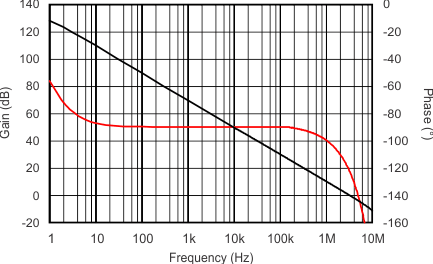
| RL = 10 kΩ / 10 pF | VS = ±2.5 V | |
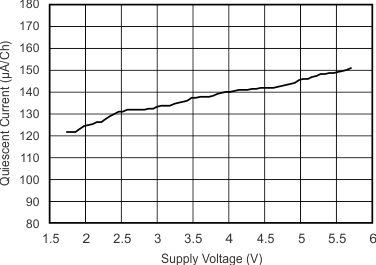
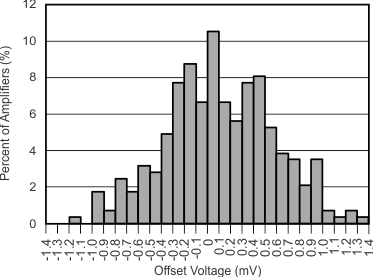
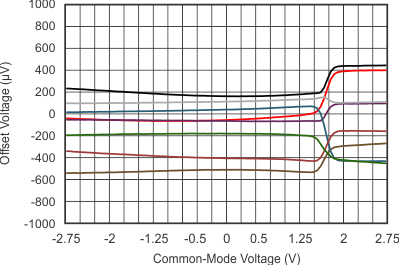
| Typical units | VS = ±2.75 V | |
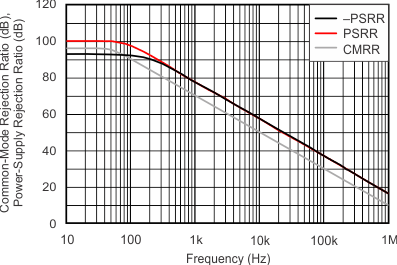
| VS = ±2.75 V | ||
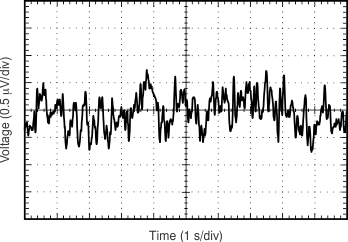
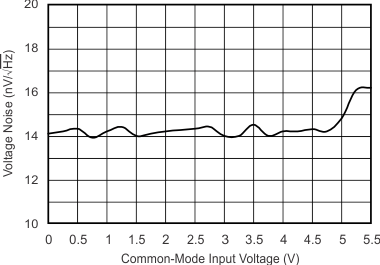
| f = 1 kHz | VS = ±2.75 V | |
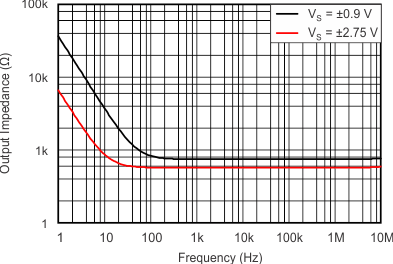
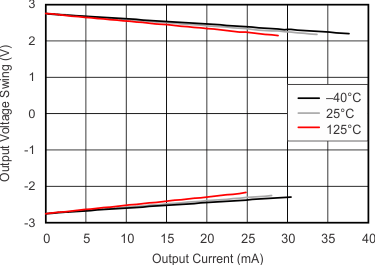
| VS = ±2.75 V | ||
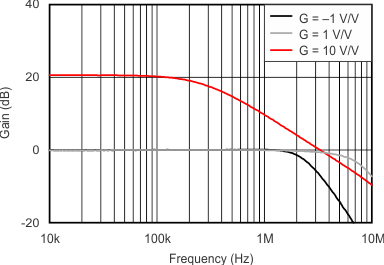
| VS = 5.5 V | ||
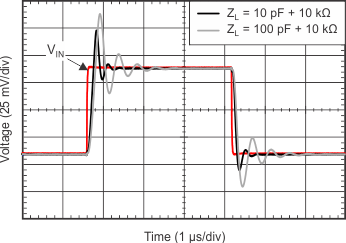
| RF = 10 kΩ | VS = ±0.9 V | G = 1 V/V |
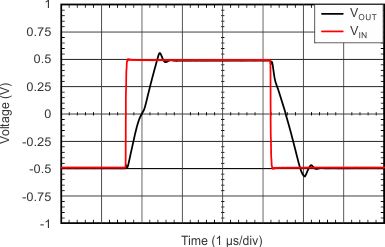
| RL = 10 kΩ | VS = ±0.9 V | G = 1 V/V |
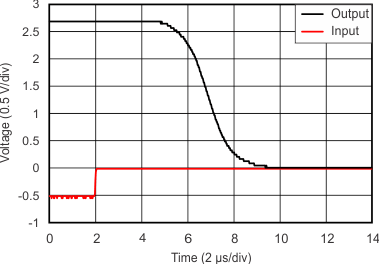
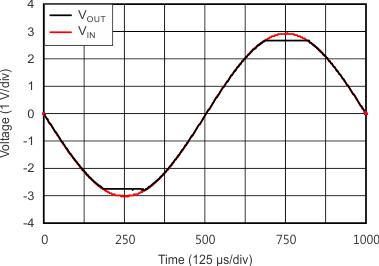
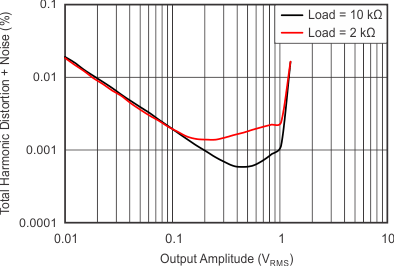
| f = 1 kHz | VS = ±2.5 V | G = 1 V/V |
| BW = 80 kHz | ||
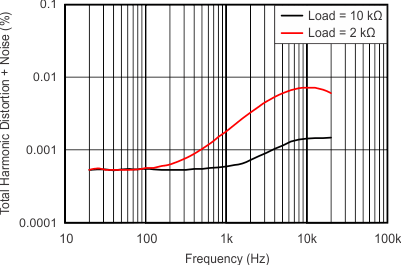
| VOUT = 0.5 VRMS | VS = ±2.5 V | G = 1 V/V |
| BW = 80 kHz | ||
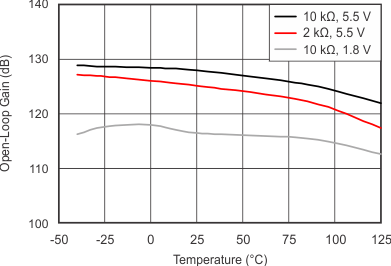
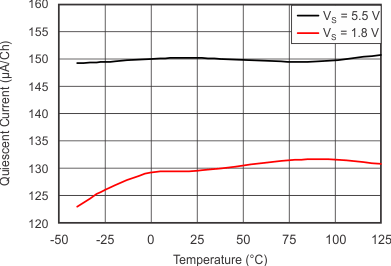
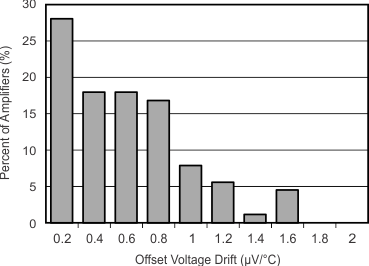
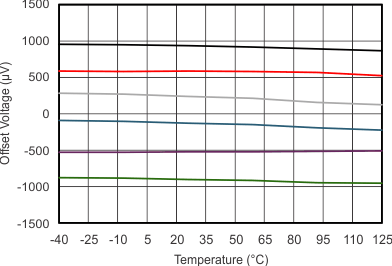
| Typical units | VS = ±2.75 V | |
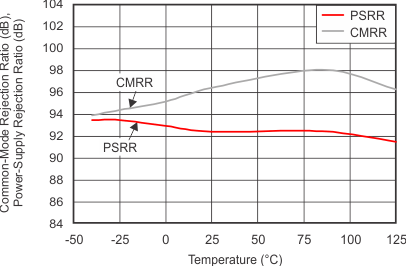
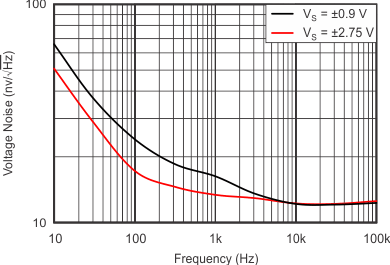
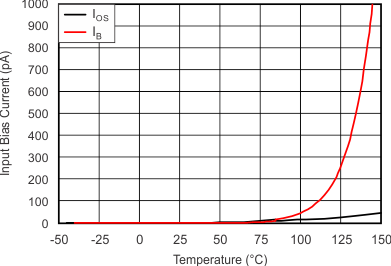
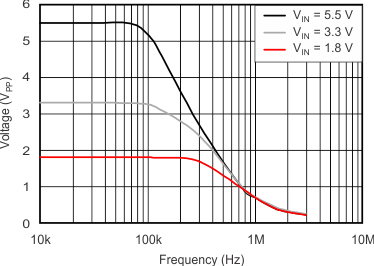
| RL = 10 kΩ | CL = 10 pF | |
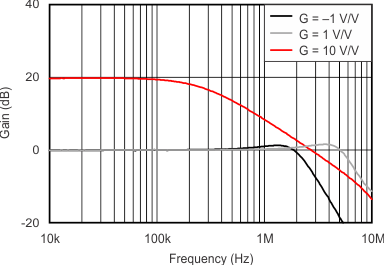
| VS = 1.8 V | ||
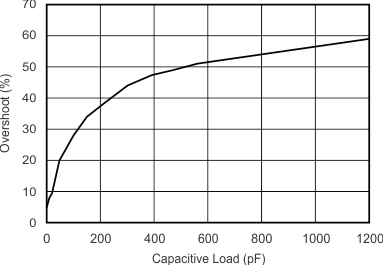
| RL = 10 kΩ | VS = ±2.75 V | G = 1 V/V |
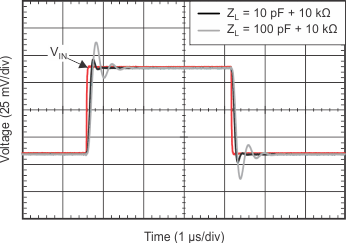
| RF = 10 kΩ | VS = ±2.75 V | G = 1 V/V |
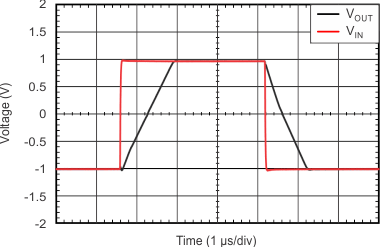
| RL = 10 kΩ | VS = ±2.75 V | G = 1 V/V |
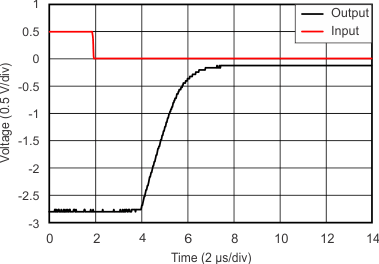
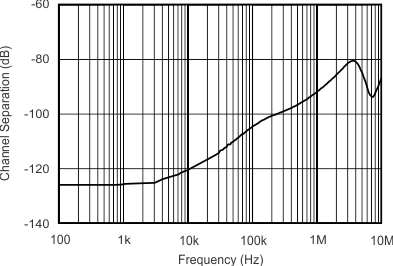
| VS = ±2.75 V | ||
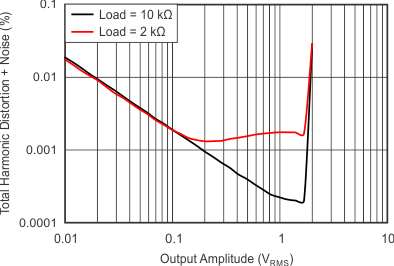
| f = 1 kHz | VS = ±2.5 V | G = –1 V/V |
| BW = 80 kHz | ||

| PRF = –10 dBm | VS = ±2.5 V | VCM = 0 V |